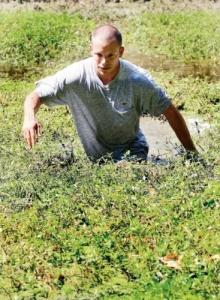Chasing a new workout by any other name ...
By Ty Johnson
Published in News on September 14, 2012 1:46 PM

News-Argus/MICHAEL BETTS
Chris Bitzenhofer makes his way through the Hillbilly Hike obstacle course at Waynesborough Park during a test run of the course. The Hillbilly Hike will be Saturday. The 5K obstacle course adventure race is being organized by Goldsboro Parks and Recreation.
There is barbed wire ahead and the zombies are closing in.
Hundreds of survivors duck under the sharp obstacle and crawl through the mud to the other side, ever mindful that the zombies are in hot pursuit.
It's not a movie though. It's a new type of footrace that thousands of athletes across the country are paying to experience every weekend.
Some races have zombies. Others mimic military training obstacle courses. They races come under a myriad of names - Spartan, Rugged Maniac, Hillbilly Hike -- but they're collectively known as "mud runs" and have grown in number over the last decade.
They aren't your typical well-paved five and 10K races across towns and through the countryside, but represent the intersection of road races, off-road hikes and extreme sports with some good-old fashioned mud splashed on for good measure.
Goldsboro Parks and Recreation is getting in on the action this year, hosting a "Hilly Hike" at Waynesborough Park on Saturday.
The path that led to this weekend's competition is one that arguably began in the 1980s in California.
At the Marine Corps Air Station in Tustin, Paul Courtaway was running the ancestors of today's mud runs, but in that day, the races weren't weekend recreational events -- they were a matter of national defense.
"They weren't races for charity," Courtaway said. "They were for Marines."
Still, visitors to the base couldn't help staring at the obstacle courses.
"When most people would come to the base and visit they would look at it and it was so physically daunting, with telephone poles and ropes and they would want to go play on it," he said.
But the allure didn't occur to the Marines, who had to undergo the endurance and strength tests as part of their jobs.
"Often in our jobs we would do training under barbed wire and play soldier, so to speak," he said. "The courses were very reflective of what we did and it kind of gave you a feel for what we went through in a day. You would end up coming home a mess."
It took seeing others enjoying the obstacle course for it to click, he said.
"What we didn't realize was how much fun it was."
Courtaway worked to tone down the course intensity to include the general public in the fun and decided to leverage the fun for charity to help out the communities.
"We found a way to make the obstacles more civilian-friendly," he said.
While Courtaway traveled from base to base across the country, he continued organizing the races, which began to involve friends and family members of Marines.
"That's what grew into the mud races," he said. "Slowly, but surely, it spread across Marine bases and, during my stint as a Marine, I was known as the guy in charge of the mud runs."
The mud finally stuck in Dallas in 1999, where Courtaway's race, The Original Mud Run, is still held today.
He estimates that in 2006, there were 13 races in the United States, most inspired by former Marines, but by 2009 they had exploded into nearly every state. Courtaway expanded his single race into a nationwide tour and other race series followed.
Here in North Carolina, the Rugged Maniac 5K tour came to Asheboro last spring, while the Timberjack Challenge premiered in Princeton in June.
More recently, the Zombie Escape at Panic Point debuted in Youngsville, where organizer Brian Garff said 1,600 racers ran from 210 zombies through an obstacle course at his haunted attraction, which opened in 2011.
Garff said that the building interest in mud runs and zombie concept fit perfectly into his facility's business plan, especially since his company leases 47 acres of adjacent farmland.
"We have a venue, makeup, experience doing this sort of thing and had a town that was willing to work with us," he said. "We saw the mud run as a logical brand extension of Panic Point."
Garff said he felt the explosion of interest in mud runs could be explained by workouts that involve more cross-training as fitness-conscious athletes aim to exercise their entire bodies.
Put simply, a weekly five-kilometer run and a T-shirt doesn't seem to be enough anymore.
"People are looking to do more total body workouts," he said, noting that athletes who compete in mud runs are often in good shape. "They value the hard work they do and want to have a lot of fun -- splashing down into mud, spinning around zombies."
Courtaway likened it to the evolution of running during the 1970s and 1980s.
"It's reflective of a society where the expected is no longer acceptable," he said.
Throughout his lifetime, Courtaway said he has seen 5Ks turn into 10Ks and then marathons and triathlons as athletes continue to try to push their limits.
Courtaway said the mud run is simply the next step as recreational running grows.
"(The Mud Run is) kind of where a 5K or a 10K -- where one of those races -- meets extreme sports and adventure sports and they slap each other in the face a bit," he said.
